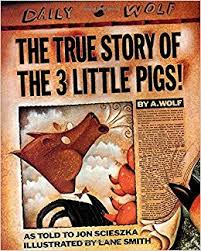The True Story of the Three Little Pigs 
The True Story of the Three Little Pigs
Scieszka, Jon. The True Story of the Three Little Pigs. New York: Penguin Young Readers, 1996.
Lexile: 510 Recommended for: Grades 3-5
Summary: This is a picture book of a spoof on the three little pigs story, this time told from the wolf's point of view. Wolf clears up some misunderstandings. According to A. Wolf, we simply have not heard his side of the story — until now.
Activity: Teaching Perspectives
Students in a 3rd grade class will read this book and learn about different perspectives in literature. We will first review the real story of The Three Little Pigs. Then students will read this book and will write about whether or not they are convinced by the wolf's version of the story using details from the text to support their claims. Does he seem trustworthy? Why or why not?
Students will then respond and discuss their findings on Padlet. Where they will connect ideas and gain multiple viewpoints from their peers.
Lesson Outcome: Students will read this book and choose a side of whether or not they are convinced with the Wolf’s perspective of what really happened in The Three Little Pigs. They will write their reasons for or against the Wolf using evidence from the text to support their claims.
Objectives:
- Students will use three pieces of evidence from the text to support their claim if they agree or disagree with the wolf’s perspective in The True Story of the Three Little Pigs (Cognitive).
- Students will present their conclusions to the class and respond through the use of Padlet to connect ideas and view multiple perspectives on the same topic (Psychomotor, Affective)
Assessments:
- Student writing
Standards:
Information Literacy Continuum:
3.6 Presents information clearly so that main points are evident.
Common Core Standards:
CCSS.ELA-LITERACY.RL.3.6
Distinguish their own point of view from that of the narrator or those of the characters.
CCSS.ELA-LITERACY.RL.3.2
Recount stories, including fables, folktales, and myths from diverse cultures; determine the central message, lesson, or moral and explain how it is conveyed through key details in the text.
AASL Standards:
1.1.9 Collaborate with others to broaden and deepen understanding
4.1.2 Read widely and fluently to make connections with self, the world, and previous reading.
No comments:
Post a Comment